Wielu użytkowników WordPressa woli pracować nad swoimi witrynami internetowymi przy użyciu lokalnego serwera na swoim komputerze. Pozwala to na prywatną pracę nad twoją witryną internetową przed udostępnieniem zmian online.
Ostatecznie trzeba będzie przenieść ją na serwer rzeczywisty, aby udostępnić ją odwiedzającym online. Przejście to ma kluczowe znaczenie dla zapewnienia prawidłowego funkcjonowania Twojej witryny internetowej na witrynie na żywo.
Pracowaliśmy nad wieloma lokalnymi witrynami internetowymi, więc musieliśmy nauczyć się najłatwiejszego sposobu przenoszenia treści na żywe witryny.
W tym artykule przedstawimy instrukcje krok po kroku, jak przenieść WordPressa z serwera regionalnego na witrynę live.
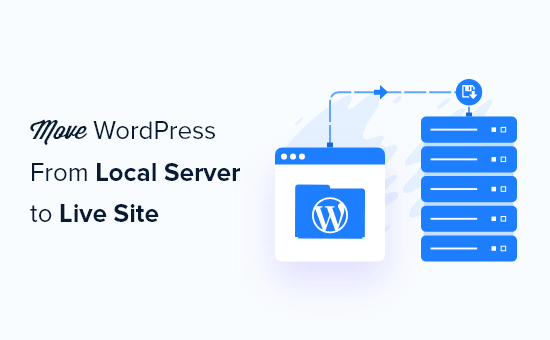
Dlaczego warto przenieść WordPressa z serwera lokalnego na witrynę Live?
Zbudowanie twojego bloga WordPress na lokalnym serwerze to bezpieczny sposób na testowanie zmian w witrynie internetowej bez posiadania wpływu na odwiedzających.
Po zakończeniu udoskonalania twojej witryny internetowej, następnym krokiem jest przeniesienie jej z lokalnego serwera na witrynę działającą na żywo.
Pokażemy dwa sposoby na przeniesienie twojej witryny z serwera regionalnego do witryny na żywo.
Pierwsza metoda wykorzystuje wtyczkę do migracji WordPress i jest zalecana dla początkujących.
W drugiej metodzie pokażemy, jak ręcznie przenieść WordPressa z lokalnego serwera na witrynę live.
Możesz wybrać metodę, która najbardziej Ci odpowiada:
Przed migracją twojej witryny WordPress
Aby przeprowadzić migrację WordPressa z serwera regionalnego na serwer rzeczywisty, trzeba mieć kilka rzeczy na miejscu.
Po pierwsze, zakładamy, że masz witrynę WordPress działającą na serwerze lokalnym (zwanym również localhost) na twoim komputerze i że masz do niej pełny dostęp.
Następnie musisz mieć nazwę domeny i hosting.
Słyszeliśmy niezliczone relacje od początkujących, którzy zaczynali od kiepskich lub darmowych dostawców hostingu i żałowali tego. Z naszego doświadczenia wynika, że wybór odpowiedniego dostawcy hostingu ma kluczowe znaczenie dla sukcesu każdej witryny internetowej.
Aby ułatwić twoją decyzję, zalecamy skorzystanie z Bluehost. Jest to oficjalnie rekomendowana firma hostingowa WordPress, która daje użytkownikom WPBeginner ekskluzywną zniżkę + darmową domenę i SSL.
Zasadniczo możesz zacząć już za 1,99 USD miesięcznie.
Jeśli szukasz świetnej alternatywy dla Bluehost, możesz spojrzeć na Hostinger. Oferują również ekskluzywną zniżkę dla użytkowników WPBeginner z bezpłatną nazwą domeny.
Jeśli możesz sobie pozwolić na zapłacenie nieco więcej, sprawdź SiteGround. Mają też specjalną ofertę dla czytelników WPBeginner.
Jeśli potrzebujesz pomocy w stworzeniu swojej witryny internetowej, skorzystaj z naszego przewodnika krok po kroku.
Wreszcie, będziesz potrzebował programu FTP i wiedzieć, jak korzystać z FTP, aby przesłać twoją witrynę na serwerze lokalnym do witryny na żywo.
Gotowy? Rozpocznijmy migrację twojej witryny WordPress.
Film instruktażowy
Jeśli wolisz pisemne instrukcje, czytaj dalej.
Metoda 1: Przenieś WordPressa z regionalnego serwera na witrynę Live za pomocą wtyczki migracyjnej (zalecane)
Ta metoda jest łatwiejsza i zalecana dla początkujących. Będziemy używać wtyczki do migracji WordPressa, aby przenieść WordPressa z lokalnego hosta do witryny na żywo.
Krok 1: Instalacja i konfiguracja wtyczki Duplicator
Najpierw musisz zainstalować i włączyć wtyczkę Duplicator na twojej regionalnej witrynie. Aby uzyskać więcej informacji, zobacz nasz przewodnik krok po kroku, jak zainstalować wtyczkę WordPress.
Pro Tip: Istnieje również wersja pro Duplicator, która oferuje zabezpieczenia kopii zapasowych, przechowywanie w chmurze, łatwe przywracanie witryn i wiele więcej.
Po aktywacji należy przejść do strony Duplicator ” Backups i kliknąć przycisk “Create New”.
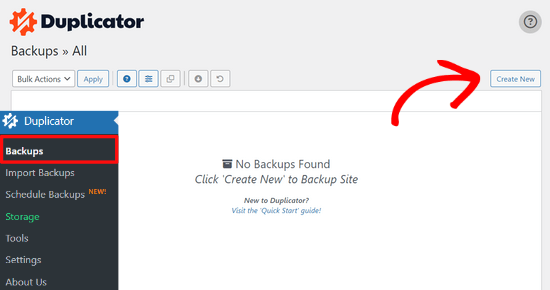
Spowoduje to wyświetlenie ekranu, na którym można nadać nazwę twojej kopii zapasowej.
Następnie kliknij przycisk “Dalej”.

Duplicator przeprowadzi teraz kilka testów, aby sprawdzić, czy wszystko jest w porządku.
Jeśli wszystkie elementy są oznaczone jako “Dobre”, kliknij przycisk “Utwórz”.

Proces ten może potrwać kilka minut, w zależności od rozmiaru twojej witryny internetowej. Należy pozostawić tę kartę otwartą do czasu jego zakończenia.
Po zakończeniu zobaczysz opcje pobierania pakietów “Installer” i “Archive”. Należy kliknąć przycisk “Pobierz oba pliki”, aby pobrać oba pliki na komputer.

Plik “Archiwum” to kompletna kopia twojej witryny WordPress. Zawiera wszystkie pliki rdzenia WordPressa, a także twoje obrazki, przesłane pliki, motywy, wtyczki i kopię zapasową bazy danych WordPress.
Plik “Installer” to skrypt, który zautomatyzuje cały proces migracji poprzez rozpakowanie pliku archiwum zawierającego twoją witrynę internetową.
Krok 2: Utwórz bazę danych dla twojej witryny internetowej WordPress na żywo
Przed uruchomieniem instalatora lub przesłaniem witryny WordPress z hosta lokalnego na twój serwer hostingowy, musisz utworzyć bazę danych MySQL dla nowej witryny na żywo.
Jeśli utworzyłeś już bazę danych MySQL, możesz pominąć ten krok.
Aby utworzyć bazę danych, należy przejść na kokpit cPanel twojego konta hostingowego. Następnie znajdź sekcję “Bazy danych” i kliknij ikonkę “Kreator baz danych MySQL”.
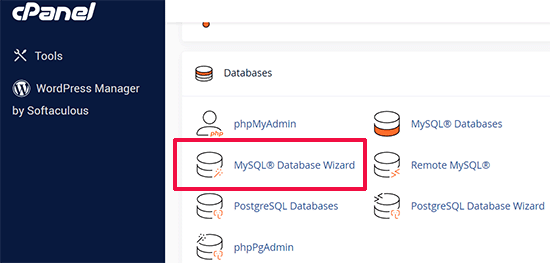
Na kolejnym ekranie znajduje się pole do utworzenia nowej bazy danych.
Wystarczy podać nazwę twojej bazy danych i kliknąć przycisk “Utwórz bazę danych”.

cPanel utworzy teraz nową bazę danych.
Następnie wpisz nazwę użytkownika i hasło dla twojego nowego użytkownika, a następnie kliknij przycisk “Utwórz użytkownika”.
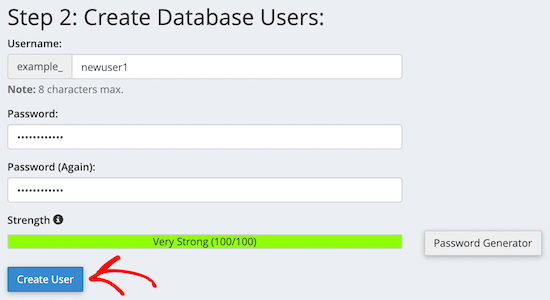
Następnie należy dodać utworzonego użytkownika do bazy danych.
Najpierw kliknij pole wyboru “Wszystkie uprawnienia”.
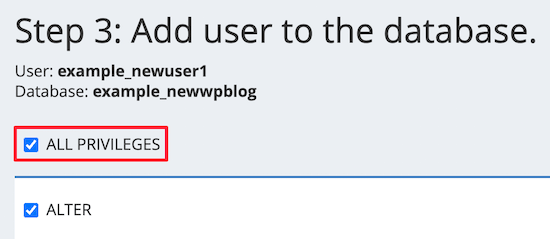
Następnie przewiń w dół i kliknij przycisk “Wprowadź zmiany”, aby zapisać twoje zmiany.
Twoja baza danych jest teraz gotowa do użycia z witryną WordPress. Pamiętaj, aby zanotować nazwę bazy danych, nazwę użytkownika i hasło. Informacje te będą potrzebne w następnym kroku.
Krok 3: Przesyłanie plików z serwera lokalnego do witryny internetowej WordPress na żywo
Teraz należy przesłać archiwum i pliki instalatora z twojej regionalnej witryny na twoje konto hostingowe.
Najpierw połącz się z twoją witryną na żywo za pomocą klienta FTP. Po połączeniu upewnij się, że katalog główny twojej witryny internetowej jest całkowicie pusty.
Zwykle katalogiem głównym jest katalog /home/public_html/.
Niektóre firmy hostingowe WordPress automatycznie instalują WordPress podczas rejestracji. Jeśli masz tam pliki WordPress, musisz je usunąć.
Następnie możesz przesłać pliki archive.zip i installer.php z Duplicatora do twojego pustego katalogu głównego.

Krok 4: Uruchomienie skryptu migracji
Po przesłaniu plików migracyjnych należy przejść na następujący adres URL w twojej przeglądarce:
http://example.com/installer.php
Nie zapomnij zastąpić “example.com” twoją własną nazwą domeny.
Spowoduje to uruchomienie kreatora migracji Duplicator.
Instalator przeprowadzi kilka testów i zainicjuje skrypt.
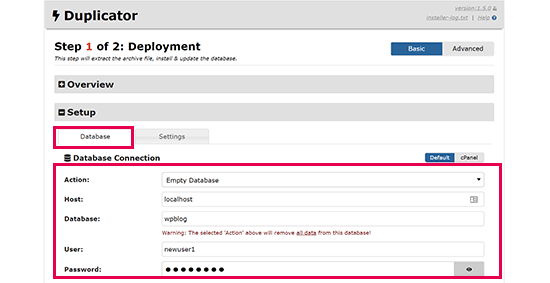
W sekcji Konfiguracja zostaniesz poproszony o wpisz swojego hosta MySQL, nazwę bazy danych, nazwę użytkownika i hasło.
Twój host będzie prawdopodobnie hostem lokalnym. Następnie wpiszesz szczegóły bazy danych, którą utworzyłeś we wcześniejszym kroku.
Następnie kliknij przycisk “Zatwierdź”, aby upewnić się, że wpiszesz prawidłowe dane.
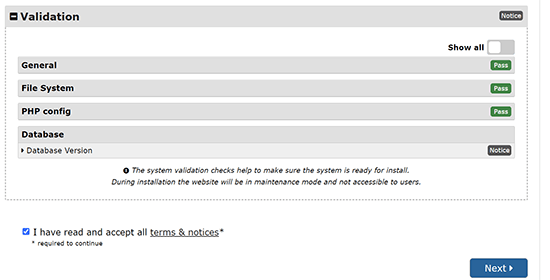
Następnie kliknij przycisk “Dalej”, aby kontynuować.
Duplicator będzie teraz importować twoją kopię zapasową bazy danych WordPress z archiwum do nowej bazy danych.
Zaktualizuje również adresy URL wskazujące na witrynę regionalną i twoją nową witrynę na żywo.
Możesz teraz kliknąć przycisk “Admin Login”, aby wpisz obszar administracyjny WordPress twojej witryny na żywo.

Po zalogowaniu się na twoją witrynę, Duplicator automatycznie wyczyści pliki instalacyjne.
To wszystko. Pomyślnie przeniosłeś WordPressa z lokalnego serwera na twoją witrynę live.
Metoda 2: Ręczne przeniesienie WordPressa z regionalnego serwera na witrynę Live
W tej metodzie pokażemy, jak ręcznie przenieść WordPressa z lokalnego serwera na twoją witrynę na żywo. Będzie to przydatne, jeśli pierwsza metoda nie zadziała lub jeśli wolisz zrobić to ręcznie.
Krok 1: Eksport lokalnej bazy danych WordPress
Pierwszą rzeczą, którą musisz zrobić, to wyeksportować twoją lokalną bazę danych WordPress. W tym celu użyjemy phpMyAdmin.
Jeśli nie jesteś z nim zaznajomiony, to warto zapoznać się z naszym przewodnikiem po zarządzaniu bazą danych WordPress za pomocą phpMyAdmin.
Wystarczy wejść na stronę http://localhost/phpmyadmin/ i kliknąć na twoją bazę danych WordPress. Następnie kliknij przycisk “Eksportuj” na górnym pasku menu.

W opcji “Metoda eksportu:” można wybrać “Szybka” lub “Niestandardowa”. Dostosuj zapewni więcej opcji eksportu twojej bazy danych.
Zalecamy jednak wybranie opcji “Szybko”, a następnie kliknięcie przycisku “Dalej”, aby pobrać twoją bazę danych.

Krok 2: Wgranie plików WordPress na witrynę Live
Teraz będziemy musieli przenieść wszystkie pliki twojej witryny internetowej do witryny na żywo.
Aby rozpocząć, otwórz klienta FTP i połącz się z twoim kontem hostingowym.
Po połączeniu się z twoją witryną na żywo, upewnij się, że przesyłasz pliki do właściwego katalogu. Na przykład, jeśli witryna ma być hostowana pod adresem “yoursite.com”, wszystkie pliki należy przesłać do katalogu public_html.
Teraz wybierz twoje lokalne pliki WordPress i prześlij je na swój serwer live.
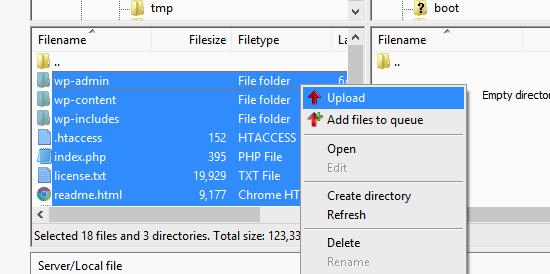
Krok 3: Utwórz bazę danych MySQL na twojej witrynie Live
Podczas gdy twój klient FTP przesyła pliki WordPress, możesz rozpocząć importowanie bazy danych na serwer live.
Większość dostawców hostingu WordPress oferuje cPanel do zarządzania twoim kontem hostingowym, więc pokażemy ci, jak utworzyć bazę danych za pomocą cPanel.
Najpierw należy zalogować się do twojego kokpitu cPanel i kliknąć ikonkę “Kreator baz danych MySQL”, która znajduje się w sekcji “Bazy danych”.

Na następnym ekranie można utworzyć nową bazę danych.
Musisz podać nazwę twojej bazy danych, a następnie kliknąć “Utwórz bazę danych”.

cPanel automatycznie utworzy teraz nową bazę danych.
Następnie wpisz nazwę użytkownika i hasło dla twojego nowego użytkownika, a następnie kliknij “Utwórz użytkownika”.
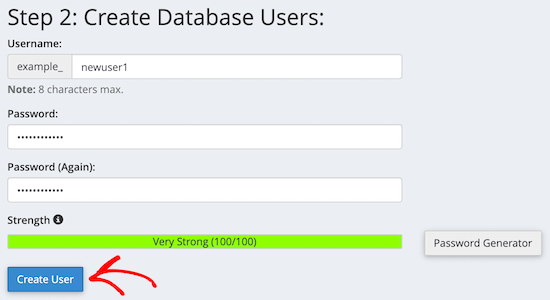
Następnie należy dodać utworzonego użytkownika do bazy danych.
Najpierw zaznacz pole wyboru “Wszystkie uprawnienia”.
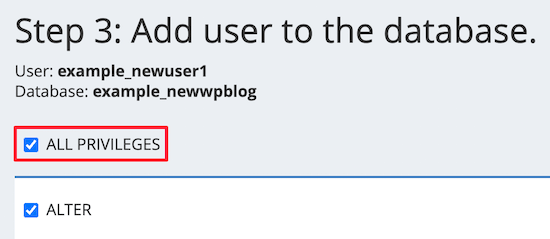
Następnie przewiń w dół i kliknij “Wprowadź zmiany”, aby zapisać twoje zmiany.
Pomyślnie utworzyłeś nową bazę danych dla twojej witryny WordPress na żywo.
Krok 4: Importowanie bazy danych WordPress do witryny Live
Następnym krokiem w procesie jest importowanie twojej bazy danych WordPress.
Przejdź do twojego kokpitu cPanel, przewiń w dół do sekcji “Bazy danych” i kliknij “phpMyAdmin”.
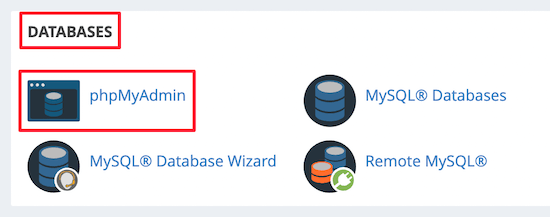
Spowoduje to przejście do phpMyAdmin, gdzie należy kliknąć utworzoną powyżej bazę danych. phpMyAdmin wyświetli twoją nową bazę danych bez tabel.
Następnie kliknij kartę “Importuj” w górnym menu. Na stronie importowania kliknij przycisk “Wybierz plik”, a następnie wybierz plik bazy danych z witryny regionalnej, który zapisałeś w pierwszym kroku.
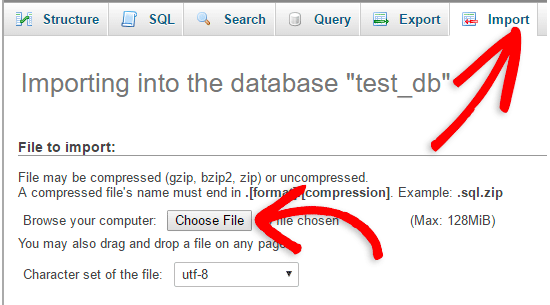
Następnie kliknij przycisk “Go” na dole strony. Twoja baza danych zostanie automatycznie importowana do phpMyadmin.
Krok 5: Zmiana adresu URL witryny
Teraz musisz zmienić adres URL witryny w bazie danych, aby połączyć się z twoją witryną WordPress na żywo.
W phpMyAdmin, poszukaj tabeli wp_options w twojej bazie danych, którą właśnie importowałeś powyżej.
Jeśli zmieniłeś prefiks bazy danych, to zamiast wp_options może być {new_prefix}_options.
Następnie kliknij przycisk “Przeglądaj” obok wp_options. Możesz też kliknąć odnośnik na panelu bocznym, aby otworzyć stronę z listą pól w tabeli wp_options.
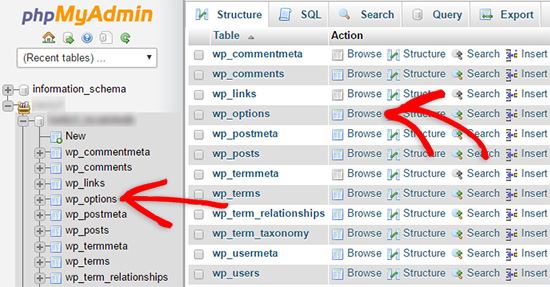
Następnie w kolumnie options_name należy wyszukać opcję siteurl.
Następnie kliknij ikonkę “Edytuj”.

Spowoduje to wyświetlenie okna, w którym można edytować pole.
W polu wejściowym option_value zobaczysz adres URL twojej regionalnej instalacji, który będzie czymś w rodzaju http://localhost/test.
W tym polu należy wstawić adres URL twojej nowej witryny, na przykład: https: //www.wpbeginner.com.
Następnie możesz zapisać pole, klikając przycisk “Dalej”.
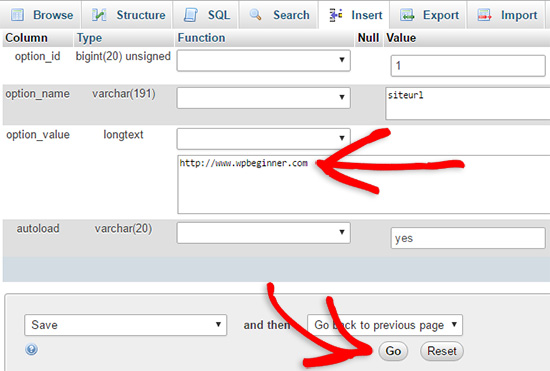
Następnie należy wykonać te same kroki, co powyżej dla nazwy opcji strony głównej. Menu wp_options może mieć kilka stron. Zazwyczaj opcja strony głównej znajduje się na drugiej stronie.
Następnie zaktualizuj adres URL strony głównej, aby był taki sam jak adres URL twojej witryny na żywo.
Krok 6: Skonfiguruj swoją witrynę Live
Teraz, gdy importowałeś bazę danych i przesłałeś swoją treść, nadszedł czas, aby skonfigurować WordPress.
W tym momencie twoja witryna powinna wyświetlać błąd“Błąd nawiązywania połączenia z bazą danych“.
Aby to poprawić, połącz się z twoją witryną internetową za pomocą klienta FTP i otwórz plik wp-config.php.
Poszukiwane będą następujące linie kodu:
1 2 3 4 5 6 7 8 9 | // ** MySQL settings - You can get this info from your web host ** ///** The name of the database for WordPress */define( 'DB_NAME', 'database_name_here' );/** MySQL database username */define( 'DB_USER', 'username_here' );/** MySQL database password */define( 'DB_PASSWORD', 'password_here' );/** MySQL hostname */define( 'DB_HOST', 'localhost' ); |
Będziesz musiał podać nazwę bazy danych, nazwę użytkownika i hasło, które utworzyłeś wcześniej.
Następnie zapisz plik wp-config. php i prześlij go z powrotem na twój serwer hostingowy WordPress.
Teraz, gdy użytkownik przejdzie na twoją witrynę internetową, powinna ona działać na żywo.
Następnie musisz logować się do twojego panelu administracyjnego WordPress i przejść do Ustawienia ” Ogólne. Następnie, nie zmieniając niczego, przewiń do dołu i kliknij przycisk “Zapisz zmiany”.
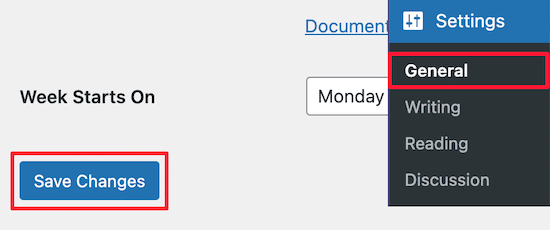
Dzięki temu adres URL twojej witryny zostanie poprawiony wszędzie tam, gdzie powinien.
Gdy to zrobisz, przejdź do Ustawienia ” Bezpośrednie odnośniki, a następnie przewiń w dół i kliknij “Zapisz zmiany”, aby upewnić się, że wszystkie odnośniki do wpisów działają poprawnie.

Krok 7: Poprawka obrazków i naprawiono odnośniki poprzez aktualizację ścieżek.
Za każdym razem, gdy przenosisz witrynę WordPress z jednej domeny do drugiej lub z serwera regionalnego do witryny na żywo, napotkasz niedziałające odnośniki i brakujące obrazki.
Pokażemy dwa sposoby aktualizacji adresów URL. Możesz wybrać ten, który najbardziej Ci odpowiada.
1. Aktualizacja adresów URL za pomocą wtyczki Search & Replace Everything (zalecane)
Najbezpieczniejszym sposobem na poprawienie tego jest użycie Search & Replace Everything. Jest to potężna wtyczka WordPress, która pozwala łatwo wykonywać zadania masowej aktualizacji na twojej witrynie internetowej bez pisania skomplikowanych zapytań do bazy danych.
Najpierw należy zainstalować i włączyć wtyczkę Search & Replace Everything.
Po włączaniu przejdź do strony Narzędzia ” WP Wyszukaj i zamień.
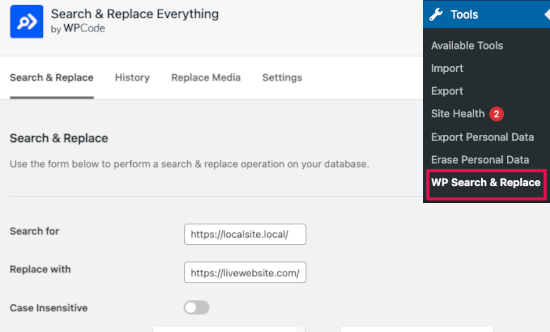
Następnie wpisz adres URL witryny regionalnej w polu “Wyszukaj” i adres URL witryny rzeczywistej w polu “Zamień na”.
Przewiń nieco i kliknij “Wybierz wszystko” pod tabelami. Dzięki temu wtyczka będzie szukać starego adresu URL wszędzie w bazie danych.

Teraz kliknij przycisk “Podgląd wyszukiwania i zamiany”, aby kontynuować.
Wtyczka przeszuka twoją bazę danych pod kątem wszystkich instancji starego adresu URL, a następnie wyświetli podgląd wyników.
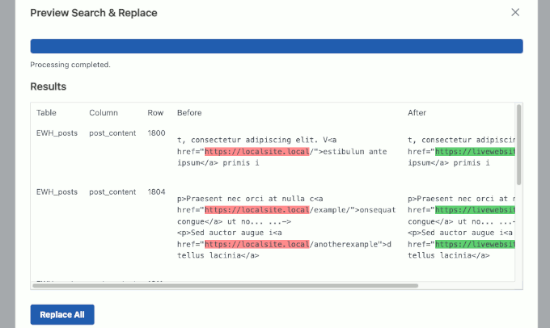
Jeśli wszystko wygląda dobrze, kliknij “Zastąp wszystko”, aby zapisać zmiany.
Zobaczysz ostrzeżenie o wprowadzanych zmianach. Kliknij “Tak”, aby kontynuować.
Wtyczka zaktualizuje teraz bazę danych i zastąpi lokalne adresy URL twoim obecnym, aktualnym adresem URL witryny internetowej.
2. Ręczna aktualizacja adresów URL (zaawansowane)
Innym sposobem aktualizacji adresów URL jest użycie następującego zapytania SQL:
1 | UPDATE wp_posts SET post_content = REPLACE(post_content, 'localhost/test/', 'www.yourlivesite.com/'); |
Wystarczy przejść do phpMyAdmin, kliknąć na twoją bazę danych, a następnie kliknąć na “SQL” z górnego menu i dodać powyższe zapytanie.
Upewnij się, że zmieniłeś je na adresy URL twojej witryny regionalnej i witryny na żywo, a następnie kliknij przycisk “Przejdź”.
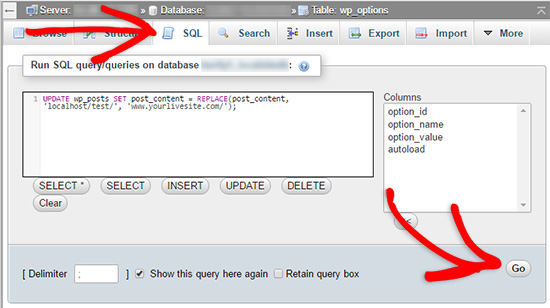
To wszystko. Pomyślnie przeprowadziłeś migrację WordPressa z twojego regionalnego serwera na witrynę live.
Miejmy nadzieję, że twoja witryna internetowa na żywo działa sprawnie. W przypadku powiadomienia o jakichkolwiek błędach, możesz zapoznać się z naszym przewodnikiem po typowych błędach WordPress, aby uzyskać pomoc w rozwiązywaniu problemów.
Mamy nadzieję, że ten artykuł pomógł ci przenieść WordPressa z serwera lokalnego na witrynę live. Możesz również zapoznać się z naszym przewodnikiem na temat przenoszenia witryny na żywo na serwer lokalny lub zapoznać się z ostateczną listą kontrolną migracji witryny, aby poznać praktyczne kroki migracji WordPress.
If you liked this article, then please subscribe to our YouTube Channel for WordPress video tutorials. You can also find us on Twitter and Facebook.





James
Hi!
Any tips on how I can fix a broken link that is still using localhost for a calendar plugin that I installed?
James
Karl
I’ve bookmarked this page in the past for future reference after I had migrated my own site about a year ago. I dragged my feet getting backupbuddy and now, wow! That plugin is a bit too much for my budget. Will most likely use duplicator to migrate their site redesign from MAMP to live.
Unfortunately, the client’s current WP install is a mess. I’m counting 6 db from previous and current site designs. I’m guessing it would be easier for me to just sweep clean all the old dbs (delete) and create a new one for my migration rather than trying to run duplicator and then have to wade through with phpmyadmin to fix any problems.
I’ll keep this page up in my browser, just in case during migration, but I wish there was a way just to overwrite the current db with my redesign db without a need to then jump back in and make changes (via phpmyadmin). Would make the migration smoother.
Too bad backupbuddy has raised their prices.
fatemeh
Hello \
I have followed all the steps but there is nothing shown on my website , I dont know whats wrong , I do appreciate your help.
Forbidden
You don’t have permission to access / on this server.
Additionally, a 403 Forbidden error was encountered while trying to use an ErrorDocument to handle the request.
This is an error I got,
Thank you
WPBeginner Support
Please see our guide on how to fix the 403 forbidden error in WordPress.
Admin
Ian
I really appreciated this tutorial – thanks. And following it to the letter has really helped solve most of my issues. However there is one that remains. The “live” site appearance looks very much like the “localhost” site, with one exception. When I go to the Dashboard and “edit” a page live, none of the text normally visible is available for me to edit. When I go to “Preview Changes” it shows a blank screen. Is there another flaw in the database structure I have missed in the conversion/upload process? Can you show me where I might have gone wrong for this to happen please? Ian
WPBeginner Support
Try updating your permalink structure. Simply visit Settings » Permalinks and then click on the save changes button without changing anything.
Admin
peter
After importing the local database to live server, my cpanel phpadmin is not working. cant access it anymore.please help
HTTP error 404
The requested page was not found.
Possible reasons why you are seeing this page:
A bookmarked URL may have changed since you last visited.
The URL was entered incorrectly.
The URL was entered with inaccurate capitalization (URLs are case sensitive).
Please re-check the URL you are trying to reach. (Go Back)
Copyright© 2016 cPanel, Inc.
WPBeginner Support
Please contact your WordPress host for support, they will be able to help you better.
Admin
Rajeev
Hi, this tutorial has worked very well and I have migrated a locally hosted wordpress site on to GoDaddy webhosting services however when I try to log in to my website (wp-admin) it redirects to a 404 error. Any suggestions on why this is happening and what to do to solve this?
Thanks
WPBeginner Support
Have you changed site URL? Remember http://www.example.com and example.com are considered two different domains. Also make sure that you haven’t installed WordPress in its own subdirectory. In that case, your wp-admin login url will be something like example.com/wordpress/wp-admin/
Admin
Vinish Chaudhary
Hello Rajeev,
Did you find the solution for this 404 error?
Gerald
Hi Syed,
I did all that was required and encountered a HTTP ERROR 500 with the notification “…currently unable to handle this request”. I’m not sure if it’s the theme I’m using that has a problem. It’s worked fine for me on another web server.
Ant recommendations on how to fix this?
The server seems to be running on php 5.5 while my localhost ran version 5.6. Does this affect it in anyway?
WPBeginner Support
Try steps mentioned in our guide on how to fix the internl server error in WordPress.
Admin
vinay
after completing 5th step when i go to the link mysit/wp-admin for next step I get these error plz help
This either means that the username and password information in your wp-config.php file is incorrect or we can’t contact the database server at . This could mean your host’s database server is down.
i hv alredy udated my wp_config.php
Kasoma
thanks for the post but my log is not displaying and when i click the pages it shows internal server error. please help to fix that
Sharon
Your instructions were great, and love that you provided pictures as well.
However, I am having an issue. I can see my site, I can see the images for the logos and pictures I have added, but the themes are not loading. They are showing up as blank. I am not sure where to start?
When I ran your sql script through my database I get a an error #1146 – Table ‘mcintyre_wp.wp_posts’ doesn’t exist.
Any help would be greatly appreciated!
Owen
This is a great tutorial, easy to follow and gets the job done!
JESH
Hi there, thank you heaps, I have sorted it out. My website domain is now stuck on mywebsitename.preview.services . How do I get rid of the preview.services? I am worried that if I change the URL on WordPress it will stuff everything up and I want to be sure I know what I’m doing. Appreciate the help.
Najeeb
Hi,
Very good tutorial.
I would like to know is it better to design a website on a local wordpress server then upload on a server like hostgator or it is also better to buy a domain on hostgator and create a wordpress website in live environment?
Please let me know i am new to this.
Jesh
Hi there,
absolute frustration has caused me comment for help. I have been trying to upload my site from local to live using MAMP and FileZilla. I have followed your steps as well as others MANY times but still to no avail. Your guide is very good and I have followed the whole thing to the end but every time I go to view my site it comes up with the domain then .preview.services . The page is an “index of” page and it won’t let me go any further. I have tinkered around with the settings but really don’t know what to do except smash my computer. Can you recommend anything? …a sledgehammer?
WPBeginner Support
When uploading files from your computer to your website, make sure you are uploading them in the correct directory. If you are not sure, then ask your web hosting service provider. Typically its called /public_html/ but it varies from one web host to another.
Also make sure that you are uploading only your WordPress files and not including the MAMP files and directories in the upload.
Admin
Gale
Just wanna let you know, you guys are freaking awesome! This is such a great tutorial! I’d been stuck for days with the links not working and you’re the only ones mentioning saving the settings! Thank you so much!
Rajat
Hi,
I just started using Hostgator. I had created a website using WAMP. I have the .sql file and the wordpress files. I am still not able to get that website show up on my domain. Can you please tell me what can i do in this regard.
Thanks for your help.
Gary Pippin
Hi,
I have created a wordpress website and it is still not live. When i open the url in browser it says “This url is under construction : Coming Soon”.. Could you please help me with this issue.
Thanks
Gary
WPBeginner Support
1. Your site may have a plugin installed that is used to display this page.
2. Your domain name may not be pointing to the directory where you have your WordPress site.
Please contact your web host, they will be able to help you better.
Admin
nick
i dont get it. like my site is live but it still have broken links and images. im trying to fix it with the my sql quary way but everything i fill in as local site and live site URLs it says 0 rows affected and theres nothing that changed. So can you explain which urls i have to fill in exactly
Julian
Hello Nick,
Are you using the query on the live phpmyadmin dashboard?
Make sure you do it on the live site through Cpanel and not on your local environment.
Kishokumar
Great word buddy, i didn’t know about this until now. Thank you so much.
Learner
Hi, I’m learnin wordpress, I’m trying to migrate my website to a new domain and new host. Should I need to activate wordpress on my new hosting account before I load from my backup website. Thanks for your help.
WPBeginner Support
Depends on what kind of backup you have. If it is an XML or RSS file, then you should first install WordPress and then import your content from those files. If the back contains database and complete WordPress files, then you need to extract and upload WordPress files to your new host and then import database from backup.
Admin
Priyangga
All works great!! but the theme doesn’t completely loaded, is the any issues? please help!!
Yuri
Thanks for the article, but ima kinda desperate here…
Lost 4 hours of working trying to figure out why in my webserver the index page keeps BLANK, even after connected the database. And my admin page gives me the error not found, i’ve been searching for a solution and nothing helps.
thanks in advance
Steve
Worked perfectly! Thanks.
Croiche Jim
thanks a lot
cheers!
precious osasumwen
pls help. i get this error when i try to access my phpadmin in my wamp server.
phpMyAdmin – Error
Cannot start session without errors, please check errors given in your PHP and/or webserver log file and configure your PHP installation properly. Also ensure that cookies are enabled in your browser.
what do i do sir
Sneha
Hi,
I have created my website on my local server and also I have used action method to navigate to different pages. But on these action methods I have given localhost permalinks only as destination address. So do I have to replace it with live address everywhere in the code or is there some method by which i can replace it at once.
Chris Cal
I’m not one to usually comment but this is an excellent post.
Great work Syed and team. Greatly appreciated.
Cheers, Chris.
WPBeginner Support
Thanks, we are glad you found it helpful.
Admin
Leslie
It was the .htaccess file!!! But I had to upload a completely new file. Thanks!!!
Courtney
Any tutorials for when you have forgotten your phpMyAdmin login info? I am stuck at the beginning! It has been a while since I have needed to login and cannot for the life of me remember. I used this site as a tutorial to set up but cannot figure out how to reset. I have seen some tutorials to reset but I am afraid it is going to mess things up as I am not an expert. Any suggestions or tutorials you can point me to? TIA
WPBeginner Support
You can login to phpMyAdmin from your hosting control panel as well.
Admin
Tyane
I’m stuck on step 6. I edited the wp-config. file and uploaded it. It gave me six errors, with most of them beginning with, ” unexpected beginning of statement” followed by the position each error is listed. I’m very new to this and my IT husband is out of town till Friday.
barshan hassan
Thanks… I love u
leon
works really well!
geeuy
great tutorial!
worked like a charm!
ashkan
hi there tnx for this article
i did all these steps and my site is up now but when i click on other pages or links i faced this eror
(Internal Server Error)
in fact I just can see the homepage
can You tell me about This?
Thatguy91
I had the same issue, go to the permalinks page and click the save button. I think it needs to “resave” the permalinks again somewhere once migrated.
mtahirian
Hello,
I have uploaded my site live. but unfortunately i can’t go to wordpress admin. the wordpress admin is working fine on local server. it has problem keep telling that : Warning: Cannot modify header information – headers already sent by (output started at /home/………/public_html/wp-content/plugins/js_composer_theme/js_composer.php:1) in /home/porseshresearch/public_html/wp-includes/pluggable.php on line 1228
Please Help
WPBeginner Support
Seems that js_composer_theme plugin is not working. Connect to your website using FTP and then download the plugin to your computer. After that you can delete the plugin from your server. This should resolve the issue.
Admin
mtahirian
Thanks for responding.
I did, as told. but the whole site is smashed up and can’t get the design correct. I need the COMPOSER.
wpbeginner
Thank you very much for your wonderful tutorial.
I am having a problem where my website is only accessible through blog.example.com but not accessible through example.com/blog
May I know what can be done to solve this?
WPBeginner Support
Your blog is hosted as a subdomain. You will need to export it to your main domain.
Admin
wpbeginner
My subdomain folder is in public_html folder.
May I know where should I export it for it to be in my main domain?
Your help is greatly appreciated.
awoyemi ayomide
thanks it help me a lot
Lars Breum Hansen
I am stuck at step 6. My site is live, but instead of going to my main page, It show my themes default main page, at gives me an 404 (because it can’t find posts, but my main page is set to be static). And I can’t login as admin, becuase then it gives me the 500 internal error?
Kim Macc
Hi.
This article is great thank you!! I have done everything and the site is live but the pages are not linking/working i get an ‘internal server error’
please help me fix this as soon as possible. have done the SQL query but to no avail.
AP
Make sure hidden files are copied over as well as part of Step 2
Ebune
i had a problem in the step where i am to change localhost/test. to my site name. i cant really see an edit but to change that stuff. also, when i try to upload my database, it gives me an error. please can anyone help??? am in a deep shit right now
Dang Ng
You could try writing an SQL statement to modify that cell and see what MySQL say
Mayur
My website is
I have changed my server , i took backup of wp files and mysql before my server service expired. Now i am on a new server, uploaded and extracted wp files in public_html, i am. Getting an error – error establishing database connection, hoe should i solve this error?
WPBeginner Support
Please take a look at how to fix the error establishing a database connection in WordPress.
Admin
Caitlin
Hi! I ran into a problem in step 6: “To fix this, connect to your website using an FTP client and edit wp-config.php file. Provide the database name, user and password you created earlier in Step 3. Save the wp-config.php file and upload it back to your server. Visit your website, and it should be live now.”
I did that and it didn’t work, so I started to edit where it said “localhost” and changed it to my domain.
I’m a totally newbie so any help would be appreciated!
WPBeginner Support
Try using localhost as your MySQL Host
define( ‘DB_HOST’, ‘localhost’ );
Admin
ananta
owh… maan… this is what i am looking for all day long… finally found your article. it’s very helpful. now, my site is live. thank you. good work by the way.
Raj jain
Hi,
How can I solve this error. Reply urgently.
Fatal error: Allowed memory size of 67108864 bytes exhausted (tried to allocate 32 bytes) in /home/sitename/public_html/wp-includes/pomo/mo.php on line 236
WPBeginner Support
See our guide on how to fix WordPress memory exhausted error.
Admin
Elise
Hello, I’ve been following all these steps but when I’m doing the export but when I’m importing in my OVH database I can only see wp_commentmeta and wp_comments instead I’ve selected all tab during the export and choose custom and the gzipped format
Do you know what’s happening here?
Amey mankar
Thank You so much. It help me alot.
Mboule A
I tried changing localhost to my domain name but it isn’t going. I need help. I’ve tried both methods. Both the plugins and using the SQL code
Bessong william
thanks you for you tutorial, but am still a beginner in web developping, i need you to teach me with a plugin like BackupBuddy or Duplicator or what ever!!!, how to migrate my website from local to live production site
cmunozro
Can’t access my website.
Error al establecer una conexión con la base de datos (unable to connect to data base)
I try accessing thorough the IP as the domain is not transfered yet. I’m not sure in the wp_options and in wp_config what data should I use.